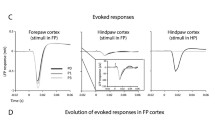Summary
(1)Pinna stimulation evoked rhythmic oscillations in the spinal cord of the decerebrate curarized cat (“fictitious” scratch reflex). The role of different spinal segments in generation of these oscillations was studied. For this purpose, destruction of the grey matter of one or of several spinal segments was performed. Besides, different numbers of caudal segments were disconnected from the rest of the cord by cooling the lateral surface of the cord. ENGs of muscle nerves and activity of spinal neurons were recorded. (2) Different parts of the lumbosacral spinal cord, i.e. the L3 and L4 segments disconnected from the caudal part of the cord as well as the isolated L5 segment, are capable of generating rhythmic oscillations with a frequency (3–4 Hz) typical of the scratch reflex. (3) Rhythmic activity of the more caudal segments (L6-S1) usually appears only provided the rostral segments (L3–L5) generate rhythmic oscillations. However, when the dorsal surface of the L6-S1 segments is cooled, pinna stimulation evokes rhythmic activity in these segments earlier than in the L3–L5 segments. (4) The hypothesis is advanced that the L3–L5 segments are the “leading” ones, i.e., they determine the rhythm of activity in the whole spinal hindlimb centre.
Similar content being viewed by others
References
Arshavsky YI, Deliagina TG, Pavlova GA (1981) Effect of local cooling of the spinal cord on the activity of motoneurons and interneurons during fictitious scratch reflex (in Russian). Nejrofiziologia 13: 428–430
Afelt Z, Veber NB, Maksimova EV (1973) Reflex activity of chronically isolated spinal cord of the cat (in Russian). Nauka, Moscow
Berkinblit MB, Deliagina TG, Feldman AG, Gelfand IM, Orlovsky GN (1978) Generation of scratching. I. Activity of spinal interneurons during scratching. J. Neurophysiol 41: 1040–1057
Berkinblit MB, Deliagina TG, Orlovsky GN, Feldman AG (1980) Activity of motoneurons during fictitious scratch reflex in the cat. Brain Res 193: 427–438
Brooks CMcC, Koizumi K, Malcolm JL (1955) Effects of changes in temperature on reactions of spinal cord. J Neurophysiol 18: 205–216
Brooks VB (1983) Study of brain function by local, reversible cooling. Rev Physiol Biochem Pharmacol 95: 1–109
Cohen AH, Wallén P (1980) The neuronal correlate of locomotion in fish. “Fictive swimming” induced in an vitro preparation of the lamprey spinal cord. Exp Brain Res 41: 11–18
Deliagina TG (1977) Central pathway of the scratch reflex in the cat (in Russian). Nejrofiziologia 9: 619–621
Deliagina TG, Feldman AG, Gelfand JM, Orlovsky GN (1975) On the role of central program and afferent inflow in the control of scratching movements in the cat. Brain Res 100: 297–313
Feldberg N, Fleischhauer K (1960) Scratching movements evoked by drugs applied to the upper cervical cord. J Physiol (Lond) 151: 502–517
Grillner S (1974) On the generation of locomotion in the spinal dogfish. Exp Brain Res 20: 459–470
Grillner S, Zangger P (1979) On the central generation of locomotion in the low spinal cat. Exp Brain Res 34: 241–261
Grillner S, McClellan A, Sigvardt K, Wallén P, Williams T (1982) On the neural generation of “fictive locomotion” in a lower vertebrate nervous system, in vitro. In: Sjölund B, Björklund A (eds) Brain stem control of spinal mechanisms. Elsevier Biomedical Press, Amsterdam, pp 273–295
Koizumi K, Malcolm JL, Brooks CMcC (1954) Effect of temperature on facilitation and inhibition of reflex activity. Am J Physiol 179: 507–512
Koizumi K, Ushiyama J, Brooks CMcC (1960) Effect of hypothermia on excitability of spinal neurons. J Neurophysiol 23: 421–431
Rexed B (1954) A cytoarchitectonic atlas of the spinal cord in the cat. J Comp Neurol 100: 297–379
Romanes GJ (1964) The motor pools of the spinal cord. In: Eccles JC, Shade JP (eds) Organization of the spinal cord. Progress in Brain Research, vol II. Elsevier, Amsterdam, pp 93–119
Sherrington CS (1906) Observations on the scratch-reflex in the spinal dog. J Physiol (Lond) 34: 1–50
Author information
Authors and Affiliations
Rights and permissions
About this article
Cite this article
Deliagina, T.G., Orlovsky, G.N. & Pavlova, G.A. The Capacity for generation of rhythmic oscillations is distributed in the lumbosacral spinal cord of the cat. Exp Brain Res 53, 81–90 (1983). https://doi.org/10.1007/BF00239400
Received:
Issue Date:
DOI: https://doi.org/10.1007/BF00239400




